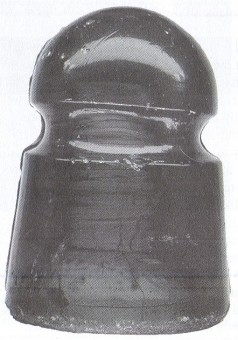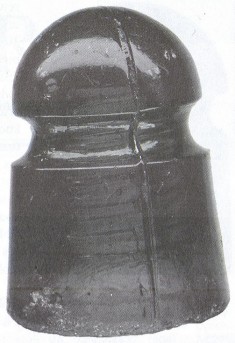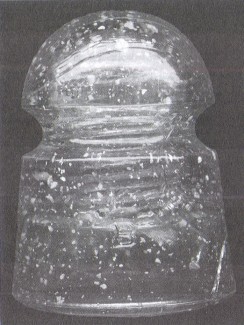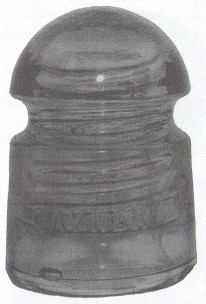Mac's Believe It Or Not!
by John McDougald
Reprinted from "Crown Jewels of the Wire", July 2000, page 17
CD 103 - A Solid Pony
I've always been a little bit partial to the CD 103. It is a solidly built
insulator, combining the best features of CD 101 (the deep wire groove) and CD
104 (the flared skirt). In spite of the fact that it was manufactured by two
well known insulator producers (Brookfield and Gayner), and one yet to be
identified manufacturer, it hasn't received much publicity in the insulator
hobby. It does have a few drawbacks as a style to covet: (1) you could put a
complete collection of CD 103's on a shelf about 18" long; and (2) you
would be looking at aqua and green insulators and not much more.
Nevertheless, I
think the style deserves a little publicity, and I have one interesting story
regarding the discovery of the newest addition to the CD 103 family. Since it is
probably the oldest of the three known CD 103 's, I'll begin with that story.
I
started collecting lightning rod balls about 20 years ago (although I didn't
know I was collecting them at the time). Over the years I accumulated a fairly
good sized group, mostly as a result of acquiring lightning rod balls that
came along with insulator collections I bought. It wasn't until we moved to
Chicago in 1989 that J really had a chance to sort through them and see what I
had. I went through the usual collecting phases of "let's try to get one of
every style" to "let's try to get one of every different style and
color" to "that's impossible, let's try to keep this collection to
what we can mount on one wall in the basement" to "oh well, it doesn't
fit on the wall any more, let's collect whatever we like." Have you been
through any of those stages in your insulator collecting?
Anyway, somewhere in
that process, I decided that one of the things I wouldn't collect was lightning
rod pendants, and I had acquired a set of four plain, white milk glass pendants
in the original box. I had met Frank Ikeman from Beloit, Wisconsin at a number
of insulator shows. He had a wonderful collection of lightning rod balls, and we
would talk lightning rod balls whenever we saw each other since he really wasn't
in to insulators.
One day I mentioned that I had this set of pendants, and his eyes lit up. He
was interested!! He had lots of LRB's to trade, but out of the blue he said,
"you know, I have an insulator you might be interested in. I got it on a
fishing trip to Russia a few years ago." I wanted to know more, but Frank
wasn't a CD expert, so he said, "I'll bring it to the next show and you can
take a look at it."
Sure enough, the next time I saw Frank, he had the
insulator. My eyes nearly popped out of my head. Out of his paper bag came a CD
103, in dark teal aqua, made from a two piece mold (MLOD). After some brief
negotiations, the set of pendants was history and I had the CD 103.
Frank
provided a little more information on the fishing trip discovery. He and some
friends were taking a guided fishing trip in the Magadin region of Russia
(Siberia to most of us). While moving toward one of the remote fishing camps,
they came across the Buediechug concentration camp from World War II. There were
still some poles with insulators on them within the concentration camp grounds.
Frank convinced the guide to climb a few poles to check out the insulators. Of
the few remaining insulators, most were dirt common U.S. manufacture (e.g.
Hemingray 9's). After satisfying himself that there was nothing interesting on
the camp grounds and enduring the cold stares of his fishing buddies as long as
possible, the group headed off to the fishing camp. About three miles down the
road, they saw a single utility pole that serviced the communication line going
to the concentration camp. One lonely insulator remained at the top of the pole.
Frank knew he wanted it, and that's when the new CD 103 appeared.
Unfortunately,
nothing is known about its manufacturer. It is unmarked, the mold line is very
pronounced, and it is the two piece molding process that leads me to believe
that it predates the other two CD 103 's. It is identical in size to the CD 103
'B' produced by Brookfield in the mid-1910's. The base, however, is flat
compared to the gently rounded base of the 'B'.

Unembossed CD 103 found in Russia.

The pronounced mold line left by
the crude two-piece mold.
The color is a rich teal aqua which is identical to many of the
Diamond-embossed CD 102 insulators found in Canada. One might speculate that the
piece may be of Canadian manufacture and found its way across the Bering Straits
into eastern Russia. The pinhole is U.S. Standard, compatible with Canadian
styles and not unheard of on some styles found in Russia.
Brookfield made the
only contribution to color variation in the CD 103 style. CD 103 B's appear in a
nice variety of light to dark aquas, and a range of greens and yellow greens. Some of the most interesting CD 103 B's are the light aqua
ones filled with snow and bubbles -- a problem for the manufacturer but a delight
to the insulator collector.

CD 103 "B" filled with flakes of
snow and bubbles.
The last CD 103 to be produced was by the Gayner
Glass Works in the early 1920's. Some have speculated that these were the result
of reworking molds received from Brookfield after they closed their business.
There is no doubt that some insulator molds moved from Brookfield to Gayner to
Lynchburg, but I do not believe that is the case for the CD 103. The Gayner CD
103 is a slightly smaller version of the style, both in overall dimensions and
in the size of the wire groove, which would make the reworking of the Brookfield mold unlikely.
I would call it a delicate CD 103,
but it is still quite sturdy. This piece remains quite rare (I would guess less
than 20 are known in collections today), but it doesn't command the price on the
market of an "only 20 known piece" because Gayner is not one of the
heavily collected manufacturers and, you guessed it, it's aqua.

CD 103 GAYNER, NO.6
Well, I hope
that brings you up to date on the CD 103, and the next time you see one in a
collection or on a sales table, just give a little nod of the head. It's a neat
style. By the way, I'm looking for a nice yellow green CD 103 'B' to add to my
collection, Believe It or Not!
| 